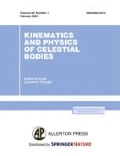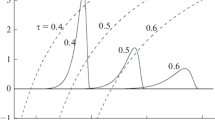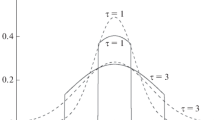Abstract
The propagation of cosmic rays in the interplanetary medium is considered based on the kinetic Fokker–Planck equation. The analytical expression for the anisotropic part of the cosmic ray distribution function is derived in the approximation of small anisotropy. It is shown that, under isotropic scattering of energetic charged particles on interplanetary magnetic field fluctuations, the cosmic ray distribution function depends exponentially on the cosine of the angle between the particle velocity and radial direction. The expression for the cosmic ray flux density is obtained. It is shown that the value of the particle flux density is defined by the spatial distribution of the cosmic ray density and by the temporal dependence of the particle density. The cosmic ray transport equations have been derived (the hyperdiffusion equation and the telegraph equation). On the basis of these equations, the spatiotemporal distribution of solar cosmic ray intensity and the anisotropy of the particle angular distribution are investigated.






Similar content being viewed by others
REFERENCES
M. Abramowitz and I. A. Stegun, Handbook of Mathematical Functions with Formulas, Graphs, and Mathematical Tables (Dover, New York, 1973; Nauka, Moscow, 1979).
B. A. Gal’perin, I. N. Toptygin, and A. A. Fradkin, “Scattering of particles by magnetic inhomogeneities in a strong magnetic field,” Zh. Exp. Theor. Phys. 33, 526 (1971).
A. P. Prudnikov, Yu. A. Brychkov, and O. I. Marichev, Integrals and Series (Nauka, Moscow, 1981; Gordon and Breach, New York, 1986).
Yu. V. Sidorov, M. V. Fedoryuk, and M. I. Shabunin, Lectures on the Theory of Functions of a Complex Variable (Nauka, Moscow, 1976; Mir, Moscow, 1985).
I. N. Toptygin, Cosmic Rays in Interplanetary Magnetic Fields (Nauka, Moscow, 1983; Reidel, Dordrecht, 1985).
V. I. Shishov, “Propagation of high-energy solar protons in an interplanetary magnetic field,” Geomagn. Aeron. 6, 223 (1966).
W. I. Axford, “Anisotropic diffusion of solar cosmic rays,” Planet. Space Sci. 13, 1301–1309 (1965).
J. Beeck and G. Wibberenz, “Pitch angle distributions of solar energetic particles and the local scattering properties of the interplanetary medium,” Astrophys. J. 311, 437 (1986).
J. W. Bieber and R. A. Burger, “Cosmic-ray streaming in the Born approximation,” Astrophys. J. 348, 597–607 (1990).
J. W. Bieber, P. A. Evenson, and M. A. Pomerantz, “Focusing anisotropy of solar cosmic rays,” J. Geophys. Res.: Space Phys. 91, 8713 (1986).
L. I. Dorman and M. E. Katz, “Cosmic ray kinetics in space,” Space Sci. Rev. 70, 529–575 (1977).
W. Droge, Y. Y. Kartavych, B. Klecker, and G. A. Kovaltsov, “Anisotropic three-dimensional focused transport of solar energetic particles in the inner heliosphere,” Astrophys. J. 709, 912–919 (2010).
J. Dunkel, P. Talkner, and P. Hanggi, “Relativistic diffusion processes and random walk models,” Phys. Rev. D 75, 043001 (2007).
J. A. Earl, “Diffusion of charged particles in a random magnetic field,” Astrophys. J. 180, 227–238 (1973).
J. A. Earl, “Analytical description of charged particle transport along arbitrary guiding field configurations,” Astrophys. J. 251, 739 (1981).
F. Effenberger and Y. Litvinenko, “The diffusion approximation versus the telegraph equation for modeling solar energetic particle transport with adiabatic focusing. Isotropic pitch angle scattering,” Astrophys. J. 783, 15 (2014).
Yu. I. Fedorov, “Cosmic-ray distribution function under anisotropic scattering of particles by magnetic-field fluctuations,” Kinematics Phys. Celestial Bodies 35, 1–16 (2019).
Yu. I. Fedorov, “The distribution function of solar cosmic rays under prolonged particle injection,” Kinematics Phys. Celestial Bodies 35, 203–216 (2019).
Yu. I. Fedorov and B. A. Shakhov, “Description of non-diffusive solar comic ray propagation in a homogeneous regular magnetic field,” Astron. Astrophys. 402, 805–817 (2003).
L. A. Fisk and W. I. Axford, “Anisotropies of solar cosmic rays,” Sol. Phys. 7, 486–498 (1969).
T. J. Gombosi, J. R. Jokipii, J. Kota, et al., “The telegraph equation in charged particle transport,” Astrophys. J. 403, 377 (1993).
K. Hasselmann and G. Wibberenz, “Scattering charged particles by random electromagnetic fields,” Z. Geophys. 34, 353 (1968).
K. Hasselmann and G. Wibberenz, “A note of the parallel diffusion coefficient,” Astrophys. J. 162, 1049 (1970).
J. R. Jokipii, “Propagation of cosmic rays in the solar wind,” Rev. Geophys. Space Phys. 9, 27–87 (1971).
J. E. Kunstmann, “A new transport mode for energetic charged particles in magnetic fluctuations superposed on a diverging mean field,” Astrophys. J. 229, 812 (1979).
Y. E. Litvinenko and P. I. Noble, “Comparison of the telegraph and hyperdiffusion approximations in cosmic ray transport,” Phys. Plasmas 23, 062901 (2016).
Y. E. Litvinenko and R. Schlickeiser, “The telegraph equation for cosmic-ray transport with weak adiabatic focusing,” Astron. Astrophys. 554, A59 (2013).
M. A. Malkov and R. Z. Sagdeev, “Cosmic ray transport with magnetic focusing and the "telegraph” model,” Astrophys. J. 808, 157 (2015).
J. Masoliver and G. H. Weiss, “Finite-velocity diffusion,” Eur. J. Phys. 17, 190–196 (1996).
L. I. Miroshnichenko and J. A. Perez-Peraza, “Astrophysical aspects in the studies of solar cosmic rays,” Int. J. Mod. Phys. A 23, 1–141 (2008).
H. Moraal and K. G. McCracken, “The time structure of ground level enhancement in solar cycle 23,” Space Sci. Rev. 171, 85–95 (2012).
N. A. Schwadron and T. I. Gombosi, “A unifying comparison of nearly scatter free transport model,” J. Geophys. Res.: Space Phys. 99, 19301 (1994).
E. V. Vashenyuk, Yu. V. Balabin, J. Perez-Peraza, et al., “Some features of the sources of relativistic particles at the Sun in the solar cycles 21–23,” Adv. Space Res. 38, 411–418 (2006).
H. J. Volk, “Cosmic ray propagation in interplanetary space,” Rev. Geophys. Space Phys. 13, 547–566 (1975).
Author information
Authors and Affiliations
Corresponding author
Additional information
Translated by M. Chubarova
About this article
Cite this article
Fedorov, Y.I. Cosmic Ray Flux in the Diffusion Approximation. Kinemat. Phys. Celest. Bodies 37, 107–120 (2021). https://doi.org/10.3103/S088459132103003X
Received:
Revised:
Accepted:
Published:
Issue Date:
DOI: https://doi.org/10.3103/S088459132103003X




